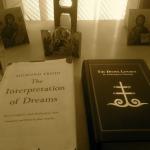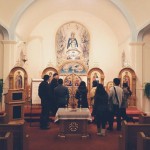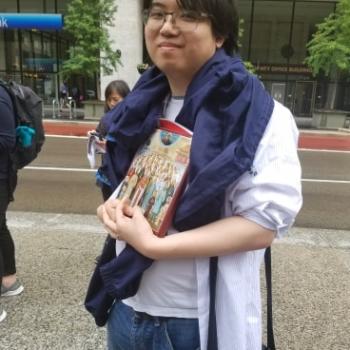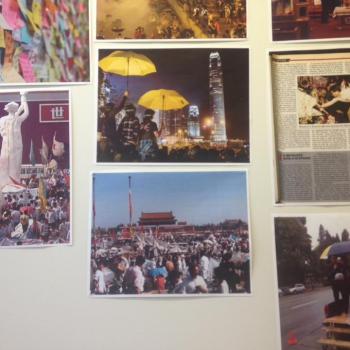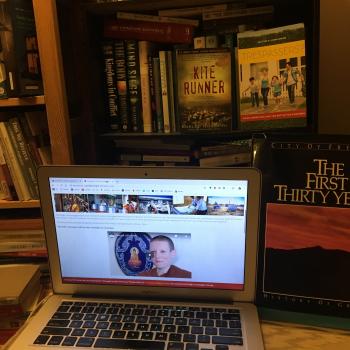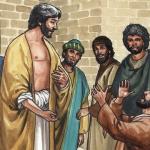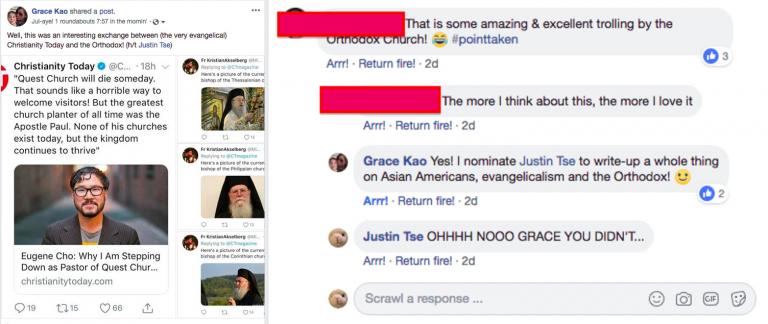
My dear friend, the Claremont ethicist Grace Kao, nominated me last week on facebook to do a write-up on Asian American evangelicals and Eastern Orthodoxy. She did so in the wake of a rather embarrassing twitter spat between some popular Orthodox leaders and the evangelical publication Christianity Today, over comments made by the popular pastor Eugene Cho on his imminent departure from his post at Quest Church in Seattle to focus on his non-profit social activism and traveling schedule. The fault was in fact Cho’s, which he himself graciously admitted. The tweet in question was Christianity Today quoting Cho making an incorrect historical statement in a fit of optimistic hyperbole:
Quest Church will die someday. That sounds like a horrible way to welcome visitors! But the greatest church planter of all time was the Apostle Paul. None of his churches exist today, but the kingdom continues to thrive.
The popular Antiochian Orthodox priest Fr Andrew Stephen Damick pounced immediately. Addressing Christianity Today, he wrote: ‘The extant-for-nearly-2000-years churches of Antioch, Corinth, Thessalonica, etc., kind of wonder what you’re talking about. I mean, did you actually even *check* whether those places in Acts were real places that actually exist and might still have Christians in them?’ Amazed by this news – ‘amazing’ is one of the longest standing buzzwords in Anglo-American evangelicalism, going all the way back to John Newton – evangelicals among Christianity Today‘s readership exclaimed their amazement. Damick then quipped: ‘Welcome to Orthodox Christianity.’
That was funny enough. But with the entry of the Greek Orthodox priest Fr Kristian Akselberg into the fray, the thing turned into a hilarious meme. ‘Here is the bishop of the current Philippian church,’ he tweeted with a picture of Metropolitan Stefanos, followed by Metropolitan Anthimos of Thessaloniki and Metropolitan Dionysios of Corinth. Memes with all three pictures, plus the original Christianity Today tweet with Cho’s picture, circulated throughout Orthodox Internet, to the great amusement of many. With all the debates about Ukrainian autocephaly and the monks of Mount Athos getting involved in the renaming of the Republic of North Macedonia, we really needed some comic relief. Of course, a Roman Catholic smart alec who wanted in on the fun also tweeted a photo of Pope Francis saying, ‘Here’s a picture of the current bishop of the Roman church.’ Unfortunately for the Latins, evangelicals are much more astute when it comes to Western Christianity. That got shut down immediately by the Southern Baptist theologian Denny Burk with the words: ‘Paul didn’t start that one.’ A Latin traddie (who might even be what they used to call a Tradinista, given how often he retweets Liz Bruenig) went in for the kill: ‘Peter did.’
I have a good idea of why Grace asked me to write about this twitter spat. It’s not only because I am Eastern Catholic, which makes me virtually indistinguishable to my evangelical friends from the Orthodox (Hilarious, I know), but also because when I was once an unserious online Anglican enfant terrible with an even lower readership than what I have now, I wrote a 4500-word monstrosity as a joke attempt to convince the reality-tv-star-revealed-as-child-predator Josh Duggar to become an Eastern Christian of some sort. It was funny at the time, because I still thought of myself as a Western Christian and was hoping to get him out of our midst. It’s a little less amusing now that I myself have become Eastern Catholic; we don’t want him, not even among the uniates. But my point is that Grace told me that if I could churn out so many words in a day, I would become one of those academics who write a book a year. Now that I’m better figured out intellectually and spiritually, I suppose I could give the Neil Patrick Harris response: challenge accepted.
Then again, I have always been accepting writing challenges from Grace, both academically and popularly. At the first time we had a serious intellectual encounter, she criticized the fundamental core of a paper I’d written for the American Academy of Religion (AAR). The experience was so cathartic that I asked her to coffee, which started a tradition of us having coffee every year at the AAR. A few years later, I joined a few Asian American evangelical bloggers in criticizing the evangelical megachurch pastor Rick Warren for putting up an old Cultural Revolution propaganda picture of a Red Guard with the caption, ‘The typical attitude of Saddleback staff as they start work every day.’ When he basically called us humorless Pharisees in contrast to the disciples who would have gotten the joke, we got mad. It seemed that, as far as Warren was concerned, the comments of actually existing Asian Americans who were fellow evangelical Protestants didn’t matter very much, that we were the ‘other’ to his normative humor. We hit back with interviews on Religion News Service, insisting that because Warren started this thing publicly, we were confronting him on the public square. I also wrote a piece on how orientalization – the framing of Asian Americans as the ‘oriental other’ – was an ‘objective offense’ and that confronting the orientalism of evangelicalism in a sustained public conversation was the right thing to do. Grace really liked the formulation I kept repeating at the time: what starts public stays public.
What I believed at the time – and I think what most Asian American evangelicals still believe to this day – is that Asian American evangelicals (or in their own parlance, ‘Asian American Christians’) have a unique voice within the networks of publicity known as evangelicalism. Indeed, what came out of the spat with Rick Warren was an Asian American ‘open letter to the evangelical church’ that recounted about a decade of Asian American evangelical activism against orientalist stereotyping within the publishing networks of evangelicalism: Vacation Bible School curriculum, skit books, self-help texts. Eugene Cho has a prominent place in this short history. In 2009, he was part of the team of bloggers that mounted an online protest to a book titled Deadly Vipers, in which two white guys Mike Foster and Jud Wilhite portrayed a bunch of personal sins as oriental ninjas sneaking up on people in their spiritual lives. What was objectionable was the same thing we took issue with when it came to Rick Warren: Asians were being portrayed as a kind of convenient oriental other, as if we didn’t exist within evangelicalism. Of course, all of this protesting got a bit hairy within evangelicalism because some folks thought we were attacking our white sisters and brothers. I guess they wanted us to see people like Foster and Wilhite on their own terms – as ‘people of the second chance.’
I’d argue that, more than anything else, Cho’s role in the Deadly Viper protest is what marks him distinctively Asian American evangelical, much more so than his personal identity as a Korean American or the church that he is leaving. This conflation of Asian identity and Asian American activism befalls quite a number of my sisters and brothers within evangelicalism, especially my buddy Soong-chan Rah, who is so supportive of my Eastern Catholicism that he invited me in spite of all my ecumenical insecurities to North Park Theological Seminary to lecture on Asian American evangelicalism. While Rah is himself Korean American, the truth is that he is more of a missiologist interested in racial justice and the histories of African American evangelicalism.
I bring up Rah in the context of Cho because Rah tells the story of the church that Cho is leaving, Quest Church, in his book The Next Evangelicalism. The short account is that Quest Church was born out of an arrangement with a predominantly white Evangelical Covenant congregation in Seattle called Interbay Covenant Church, in which the white people saw the demographic writing on the wall and merged themselves and their sizeable resources with the fledgling multicultural mission that Cho was planting. It’s one of these ‘amazing grace’ moments in contemporary evangelicalism where Christians actually do what my patron saint Holy Justin the Philosopher and Martyr says that Christians do: they love each other. The result has been quite astounding. Certainly Quest Church has its Asian Americans (especially among its pastoral staff), but it is basically something of a cross between a black church, a Korean church, and a Pentecostal church in the Evangelical Covenant Church movement that puts equal emphasis on the integrity of bodily holiness, the preaching of Scripture, and racial justice. It has also grown tremendously. In fact, in perhaps one of the greatest ironies of evangelicalism in Seattle, Quest Church purchased the building that had once been the flagship Ballard campus of the New Calvinist megachurch Mars Hill Church, the multi-sited juggernaut powered by the bombastic pastor Mark Driscoll who used to declare that other churches would die if they did not stay faithful to the Gospel, which for him included keeping both politics and women out of ministry. In a scandal over intellectual property and financial impropriety, Mars Hill Church imploded, only to have its building taken over by a church emphasizing racial justice with women on its pastoral staff. Quest Church is not an ‘Asian American church’ – it is so much more than that – and Cho’s bodily comportment as a Korean American is a prism by which cross-racial interactions that are atypical in evangelicalism are supposed to happen.
But the part of Eugene Cho’s political praxis that is Asian American is his protesting against orientalism within evangelicalism – just like, I’d say, the part of Soong-chan Rah’s practice that is Asian American includes his own fight against the Vacation Bible School curriculum Rickshaw Rally in 2004, five years before Deadly Viper went down. Asian American, in other words, does not describe biological and demographic identification as much as it denotes praxis. As the journalist Jeff Chang notes in his foreword to Karen Ishizuka’s popular history of the Asian American Movement of the ‘Long Sixties,’ to be Asian American in its original conception was to ‘pick a fight’ with a world that saw you as an oriental, a rug, a thing. In response, Asian American is a politics, a practice, an action born out of the radical premise that someone whose mind and body has been colonized by orientalist fantasies is in fact a person.
This anti-orientalist praxis is what made Cho’s words in his interview with Christianity Today – that none of the Holy Apostle Paul’s churches exist today – really embarrassing: he forgot about the Orthodox. The knee-jerk reaction about such ecclesial amnesia, of course, is that Asian American evangelicals tend to think of themselves, like most evangelical Protestants do, as the normative Christians and therefore know very little about the Body of Christ outside of their networks of entrepreneurial communities. I have been guilty of this faux pas myself. In a running gag on this blog, I tell the story of how one time I was teaching a course on trans-Pacific Christianities and declared that Eastern Christianities don’t matter in this geography because only the Latin Church and its discontents (Protestants) were responsible in the making of Christianity in Asia. I ate my words about a year afterwards when I became Eastern Catholic.
But true as this insight about evangelical normativity may be, they don’t take into account a strand of Asian American evangelical practice that is not exactly oblivious to Orthodoxy. In a recent issue of the Asian American evangelical magazine Inheritance, my piece about becoming Eastern Catholic was far from the only article to talk about Orthodox practices; there is actually an essay in there written by an Asian American iconographer in the San Francisco Bay Area. I have a friend who is a recently ordained pastor in a small, independent church in Vancouver who also trained with the Melkites in iconography (and also attended Jerusalem Matins in Jerusalem last year), and the community where she served as my pastor before my conversion to Eastern Catholicism puts up Rublev’s Trinity on a PowerPoint screen during communion. Quest Church’s executive pastor Gail Song Bantum is married to the theologian Brian Bantum, who is part of a trio of theologians of race (along with J. Kameron Carter and Willie Jennings) emanating from Duke University who put to what the Orthodox would call ‘Holy Tradition’ – the spiritual teachings of our mothers and fathers in Christ handed down to us over time – to work in critiquing the modern fantasies of orientalism, settler colonialism, anti-miscegenation, anti-Semitism, and just outright racism.
Icons, the repetition of the Jesus Prayer, the way of negation, hesychasm, the teaching of the holy mothers and fathers, even the liturgies of our churches – these are not foreign to the strand of Asian American evangelicalism emphasizing spiritual formation and the political practices of social justice. In fact, though I have not spoken to Cho personally about this, there is a reasonable amount of evidence that his work intersects with these themes. He’s written about practice of prayerful negation in his book Overrated, which is a confession of sorts that reveals the importance of spiritual examination in the course of working for social justice lest one become filled with hubris. On the question of Cho’s activities, his speaking at venues like the Justice Conference and his work with the non-profit organization One Day’s Wages, which attempts to ‘end extreme poverty,’ reveal his prioritization of economic and racial justice at a global scale. In fact, the undercurrent of his Christianity Today interview is that these social justice activities have become so much of a priority for him that he is going to have to leave his lead pastoral post at Quest Church in order to concentrate on his calling.
In other words, Eugene Cho probably knows better. What he gave to Christianity Today was probably a slip of tongue, a Freudian slip in more ways than one. After all, Freud reveals that these mistakes can tell us a lot about the person who made them and their personal experience of the world. They tell you more about them than the situation in the world. What we learn from Cho’s mistake concerns his ecclesiology – not only how he imagines the church in a theoretical way, but also how he’s experienced it. I will not attempt to psychoanalyze the man without talking to him and getting his full, informed, voluntary consent to write about the encounter. But working purely from the public record, there are some insights to be gleaned. To put it starkly, Interbay Covenant Church had to die in order for Quest Church to live. Quest Church now inhabits the building of another church that died of hubris, Mars Hill Church. Indeed, Mars Hill’s implosion is truly ironic, and since we are speaking ill of the ecclesially dead, I have to tell another story about it. Just over a year before it joined the dustbin of history, Mars Hill Church’s lead pastor Mark Driscoll made a video promoting his last and final book – the one that got dinged for plagiarism – by driving a hearse to a church building that used to belong to University Baptist Church, a congregation that had been involved in the Sanctuary Movement in the 1980s to house those fleeing from American imperialist wars of regime change in Latin America. He claimed that because that church had not preached the Gospel, it had died, and Mars Hill had taken over. A little over a year later, that campus shut down for good. Meanwhile, University Baptist Church still exists. Far from being dead, it had simply moved a few blocks down the street into a smaller building.
Ecclesiologically speaking, Cho is saying that if you say that your church will never die, your congregation is probably – in the title of his book – overrated. In fact, most people in evangelicalism, even and especially the powerful people, would agree. In Calvary Chapel Distinctives, Chuck Smith – the Pentecostal pastor who oversaw the conversion of thousands of hippies in Southern California during the Jesus Movement – says that part of his church Calvary Chapel’s distinctive success is that it was not afraid to close popular programs if they got in the way of further growth in the Spirit. A case in point, Smith points out, was the Saturday night concerts that was the site where the hippies usually met the Lord. After a while, it became more of an obligatory program steeped in nostalgia than an exciting venue of evangelization, and instead of letting it die a slow death, they cut it from the church’s programming altogether. As Smith puts it, churches are not museums, and preserving a program for old time’s sake is the surest way to make sure your whole church dies. To avoid church death, the programs must die. Mark Driscoll would agree. In one of the most controversial lines in Confessions of a Reformission Rev, he asks if his readers are ready to ‘shoot their dogs,’ to fire incompetent staff and to excise programs that are not working, if it means furthering the kingdom of God. It’s not just the big church people who say these kinds of things either; the advocates for the small church, like Eugene Peterson and Marva Dawn, talk about how pastors should become ‘unnecessary’ in their congregations, because nothing – especially not a cult of personality – lasts forever. Eugene Cho is not crazy to be talking about ecclesial death, in other words. It’s standard-issue vocabulary in church growth, planting, and evangelization circles within contemporary evangelical Protestantism. Discussing the possible death of the baby ecclesia and its programs that you brought into the world is a marker of humility among these people. Cursing other churches and discussing their demise, on the other hand, will land you the divine smackdown. In this sense, Eugene Cho is truly the anti-Mark Driscoll. But in another sense, even Driscoll would not find Cho’s formulation unreasonable.
But that’s how a little bit of hyperbole can get a person into a lot of trouble. When we in the Orthodox and Catholic churches hear about ecclesial death, we feel like a limb has been ripped out of our bodies. It is painful and means that we feel like we have phantom limbs that cause us to relive the pain daily. For us, ecclesial death is not a matter of organizational entropy and entrepreneurial savvy. It’s usually the result of violent persecution. When we say that Catholic Christianity was wiped out in Japan and that all that was left for a time were the ‘hidden Christians,’ this is a source of pain, one with which we identify viscerally in Endō’s Silence. When we say that Daesh has nearly wiped out Christianity from its homeland, we are not being nostalgic for Christian history; we are screaming at a gut level from the pain of sisters and brothers in the Antiochian, Alexandrian, Syrian, Greek, and Latin churches having their heads cut off and their beautiful bodies blown up. When we talk about the fall of Constantinople to the Ottomans and the devastation of Kyivan Rus’ by the Mongols, we are talking about our churches having been cut to pieces by the sword. When the Moscow Patriarchate accuses the ‘uniates’ and ‘schismatics’ of being the ‘bleeding wound of the Body of Christ,’ they are literally accusing us of violently taking over church buildings and slaughtering people (claims that we’ve had to refute from the historical record and contemporary practice time and time again), and when we accuse the Moscow Patriarchate of siding with Stalinist and Putinist regimes of invasion in Ukraine, we are saying that they are literally killing our people and displacing them. The death of churches for us is not metaphorical and nothing to joke about. It drenches the soil with blood and turns our waters red. Talking glibly about how persecution is great for the church by nonchalantly quoting Tertullian’s formulation about the blood of the martyrs being the seed of the church is frankly the provenance of suburban Americans whose worst experience of ‘being persecuted’ is to have to say ‘happy holidays’ at Christmas.
Therein lies the offense of saying that the Holy Apostle Paul’s churches don’t exist anymore. After all the struggling to stay alive over two millennia despite natural disasters, geopolitical shifts, and violent persecution, having one’s existence denied in print by evangelical Protestants – the only Christians who tend to have the fantasy that they are normal and that their organizations are simple and user-friendly because they dominate global Christian discourse – is rather unsettling. In fact, it feels right that Fr Andrew Stephen Damick was the guy who fired the first shot. Speaking of ecclesial death and the struggles for a church to survive, he and the scholar of Arab Orthodoxy, Sam Noble, authored a brilliant explanation of why the Antiochian church skipped the Holy and Great Council organized by the Ecumenical Patriarchate. In 2014, the Antiochians broke communion with the Greek Orthodox Patriarchate of Jerusalem, accusing it of infringing on its territory in Qatar by setting up its own bishop for the one Orthodox temple out there and then proceeding to claim the chunk of Antiochian territory in which Qatar is based for its own jurisdiction. Unable to take communion with the Greeks from Jerusalem, the Antiochian Orthodox pulled out of what was supposed to be a pan-Orthodox council to regularize a number of canonical difficulties within Orthodoxy. Damick and Noble point out that the real problem is a kind of ecclesial racism. The Antiochians are Arabs, while the Orthodox in both Jerusalem and Constantinople are Greeks. What this situation looks like is the Greeks taking advantage of the Arabs being pillaged by political unrest to carve out some territory for themselves. That kind of action is tantamount to wishing death upon a church, and that’s definitely something over which to break communion. Of course, Damick and Noble point out that the jurisdictional clashes trigger an automatic break in communion. But restoring it with such egregious actions having been perpetrated – that’s not going to be easy, which is another way of saying that it’s not good to act like some churches are dead.
Arguably, Damick is doing something similar in his tweet. He’s saying that it’s time that evangelical Protestants stop coming off as if they are the only Christians because that’s tantamount to wishing death on the rest of us. It’s like that other time that the current president of InterVarsity Christian Fellowship, Tom Lin – who is another guy who also always gets celebrated as an ‘Asian American evangelical’ because evangelicalism can show off yet another nonwhite face – went to Ethiopia and wrote what he thought was an inspiring report about Christianity spreading there. What he meant, of course, was that evangelicalism had gotten there, so despite the political stupidity and outright fascism of the Americans, he’s not willing to give up on global evangelicalism. Of course, Christianity existed in Ethiopia long before evangelicalism developed its first network, and despite histories of European colonization that have also resulted in their shattering just like everywhere else in the world, those churches are also far from dead.
Here, then, is where we get back to what Asian American evangelicalism is supposed to embody: anti-orientalist praxis within evangelical networks. The question, I think, is thus – what, really, is orientalism? The best person to turn to, I think, is a Palestinian Christian scholar named Edward Said, who wrote a book titled Orientalism. At its core, Said says that orientalism is an imaginative geography. It’s a fantasy rendering of the world map, a framing of the lands and waters from Turkey to the Pacific Islands (arguably including Turtle Island) as being the same cultural expanse: exotic, passive, static. Once framed as an intellectual discipline with respectable schools in Western Europe and North America, orientalism is in Said’s hands a psychoanalytical mess, a knot in the intellect. One of the key problems, Said suggests, is that orientalists usually don’t pay attention to historical events and contemporary practices in what they call the ‘orient.’ Instead, they prefer to have a ‘textual attitude,’ a fondness for exegeting what they deem classic texts that will disclose to them the traditions that wind their way through ‘oriental’ culture. The orient in the mind of an orientalist is nothing more than a psychic projection, then, telling us more about orientalists than the orient. In fact, herein lies the tragedy (or farce, depending on how you look at it): this fantasy contrast between East and West which actually only exists in European intellects really means that the ‘West’ cannot really survive without positioning itself against the ‘East.’ You can’t just get rid of orientalism. It’s what sustains a ‘Western’ identity.
Amidst all the contemporary talk about ‘global Christianity’ and ‘world Christianity,’ it’s easy to forget that evangelicalism’s existence is premised on precisely this kind of Western mythology. Like orientalism, evangelicalism is also supposed to be an intellectual tradition, and that is only the first of their similarities. In the 1948 convocation speech at Fuller Theological Seminary that arguably coined the term ‘evangelicalism,’ Fuller’s first president Harold Ockenga defines the evangelical agenda as a form of theological resistance to the nihilism of late Western civilization, evidenced by the evils of fascism, Nazism, and communism. For Ockenga, evangelicalism is a recovery of the West’s moral tradition, one that is premised on the telling of ‘propositional truth,’ the checking of every uttered statement as factually true or false. There’s an orientalist move here too: Ockenga then contrasts this propostionalism over against everything to the east of his Anglo-American empiricist tradition as the ‘menace of communism, of Romanism, and […] a possible perversion of ecumencalism’ and calls for the founding of ‘an institution which will grow with the American West’ (Fuller Voices, p. 18). As Ockenga reveals in the foreword to the 1978 Harold Lindsell text The Battle for the Bible, this propositional formulation of evangelicalism is the foundation of ‘biblical inerrancy,’ the obsession with whether every sentence in the Bible is objectively and scientifically true. The propositional truth of the Bible, in other words, is linked to the salvation of the West, and this claim is historiographically uncontroversial – historians from George Marsden to Matthew Avery Sutton (who is one of Marsden’s critics) remark on the civilizational aims of contemporary evangelicalism all the way back to the 1890s (and maybe going back as far as the Second Great Awakening in the early nineteenth century – or even to the First Great Awakening in the seventeenth century, if you’re Mark Noll or David Bebbington).
As the religion scholar Rudy Busto points out, Asian American evangelicalism in practice tends more to be about fitting into this Western complex than about resisting orientalism. Recall the online activism against Rickshaw Rally, Deadly Viper, and the Rick Warren Red Guard propaganda picture that resulted in the Asian American open letter. In this trajectory of protest, the central claim is not just that white evangelicals have stereotyped Asian Americans as exotic orientals, but also that real-life Asian Americans actually exist in the networks of evangelicalism and deserve a seat at the table. In the words of the journalist Helen Lee, Asian Americans are ‘silent no more,’ serving in positions of leadership in evangelical churches and parachurch organizations and vocally protesting their erasure in the minds of their white sisters and brothers. But in the way that Busto tells the story, this phenomenon is not so much a celebration of inclusion as it is a case of Stockholm syndrome. If evangelicalism is really a networked mission to save the West – and if the imaginary of the ‘West’ is premised on orientalist imaginative geographies – then any measure of protest against orientalism mounted by Asian American evangelicals is ultimately bound to fail. Instead, Asian American evangelicals will be psychologically subsumed into these patterns of thinking. In the immortal words of the Asian American literary enfant terrible Frank Chin, ‘Christian conversion is cultural extinction and behavior modification. The social scientists call it “acculturation.” Acculturation is not a natural process’ (Chin, ‘Come All Ye Asian American Writers of the Real and the Fake,’ p. 18). Assimilation into evangelicalism means to take on evangelical modes of imagining the world. For Chin, what that means is the framing of Asian literary myths and spiritual practices as superstitions to be discarded.
But what it also means in this case is to premise the existence of evangelicalism as a fantasy of normative Christianity. Eastern Orthodoxy doesn’t fit a Western imaginary of what modern Christianity should be, so it must be historical and non-existent in the contemporary world. Here, the place of evangelicalism within the larger constructs of Western Christianity is fully put on display. Citing Said, the liturgist Robert Taft SJ says that one of the worst habits of the Latin Church – and thus, presumably also its Protestant discontents – is to consider Orthodox liturgy as the source of the Roman rite. That kind of presupposition is orientalism in two senses. First, it denies that the Western tradition has intellectual legs to stand on without an orientalist fantasy constituting it. In Taft’s analysis, the liturgical tradition that developed in Rome is fundamentally different from the liturgy that progressed from Jerusalem to Antioch to Byzantium. Their beauty lies in their difference, in the sense that both are Christian, both can trace themselves to the apostles, and both have a poetic integrity that does not need to be supplemented by the other. The second problem follows from the first: by calling the Byzantine liturgies the sources of Western liturgy, are not Western Christians saying that they have superseded Eastern Christianity? The point of urtexts is that they are buried, dead, non-existent in the contemporary sense. It’s easy in this sense to assume that the Holy Apostle Paul’s churches don’t exist anymore. They’re supposed to be the source of what we have now, and sources are historical, and when you say that something’s history, it means it’s not around anymore.
Breaking out of this orientalist mode is going to take more than information. Eugene Cho is gracious enough to admit his error. But the solution he proposes may not be enough to unseat the deep orientalist impulses of evangelical Protestantism: ‘It appears that I provided incorrect information about none of Apostle Paul’s churches still existing today. This is my error and not CT since this is an interview and not an article. My apologies for my error. It’s humbling to be wrong…but motivates me to keep learning.’ Alas, information never cured anyone of orientalism. We in the Orthodox churches know that too well. With all the white evangelical converts we get, we are all too familiar with dudebros importing their evangelical orientalism into our churches. They bring in so much information in the sense that they are obsessed with our texts. The problem is that – for those who actually succeed in becoming Orthodox in comportment – it takes them a lot of time, effort, blood, sweat, and tears to figure out that you can’t just absolutize the teachings of the holy mothers and fathers (or worse, the ‘holy’ canons) and apply them like a fundamentalist Protestant applies the Bible. Orthodoxy is about economia, about the practices that build up the house of God, which means that you can’t have what Said calls a ‘textual attitude’ about it. This obsession with texts, as the Greek Orthodox scholar Haralambos Ventis recently put it, is probably better termed orthodoxism, the reduction of the life and vitality of the Orthodox Church to a set of propositional ideologies culled from dead letter. Textual information has been the surest way to reproduce orientalism in our churches. In fact, for Said, it’s what constitutes orientalist imagining.
My modest proposal, then, is that Asian Americans who find themselves in evangelical networks and those of us who belong canonically to the Orthodox churches should encounter each other as real people. For one, it’s what Said would have wanted:
In the first place, it would be wrong to conclude that the Orient was essentially an idea, or a creation with no corresponding reality…There were – and are – cultures and nations whose location is in the East, and their lives, histories, and customs have a brute reality obviously greater than anything that could be said about them in the West. About that fact this Study of Orientalism has very little to contribute, except to acknowledge it tacitly. But the phenomenon of Orientalism as I study it here principally deals principally, not with a correspondence between Orientalism and Orient, but with the internal consistency of Orientalism and its ideas about the Orient (the East as career) despite or beyond any correspondence, or lack thereof, with a “real” Orient. (Said, p. 5).
In other words, Said has no problem with acknowledging the differences among peoples as they encounter each other as real persons, but the problem of orientalism is that those distinctions are generated through textual exegeses projected as fantasies onto the real world. A little bit of information, in other words, is very dangerous, but a lot of love, to quote the Holy Apostle Peter, can cover a multitude of sins.
But second – and I think this is the more important point – Asian American evangelicals and the Orthodox have usually been driven apart by the wedge of ethnic assimilation in North America. Structurally, there are a lot of similarities between themes that one might hear from these churches: generational problems, gendered patriarchies, political conservatism and apathy, and so on and so forth. That is because in a sociological sense, there is not much that is different between a Greek, Russian, and Arab Orthodox temple and a Chinese or Korean Protestant congregation. Both are ethnic churches; both face the question of assimilation in America and Canada. But the galling thing is that whereas those of us whose genetic ancestry is from East Asia will never look white, Greeks, Slavs, Arabs, and Jews can pass much more easily. This question of who is assimilable in North America has driven a wedge between our communities, with neither of us realizing that what could bring us together is our common resistance against orientalism. As the critical theorist Slavoj Žižek says in his book on Christianity, the last respectable prejudice of Western Europeans and North Americans who see themselves as liberal multiculturalists is against those they term Eastern Europeans from the Balkans and beyond. This racism – presumably against people whose skin is considered ‘white,’ which leads to the foolish thought that it’s not racism – is steeped in orientalism, and as those of us in the Kyivan Psychoanalysis Study Group often discuss, it’s a colonization that often leads to death by suicide, often because it’s an assimilation that leads to the abandonment of one’s community on the one hand and the support for its gentrification (and thus further displacement) on the other.
I realize now that I have exceeded even the 4500-word monstrosity for which Grace remembers me by another 1500 words. But I do so in the attempt to seize the opportunity that Eugene Cho’s Freudian slip about the Holy Apostle Paul’s churches no longer existing affords those of us working to uproot the passion of orientalist fantasizing in the Christian churches. In psychoanalytic terms, one might say that evangelicalism has a death-drive, a tendency toward entropy and an acceptance of the disintegration of its organizational structures. But the celebration of death is not a Christian impulse. Those of us in the Orthodox churches are much more interested in resurrection, the trampling of death by death by Jesus Christ who is risen from the dead and to those in the tombs bestowing life. As Metropolitan John of Pergamon puts it, this resurrectional dimension of existence happens via the passage from the natural biological drives for survival to the sharing of the eucharistic Body and Blood of Christ in the Church. Churches cannot die because they compose the living Body of Christ. Tapping into this ontological reality will require more than information. It will require evangelicals to come out of the fantasy that they are normal Christians. Part of that exodus will involve real-life encounters with those of us in the Orthodox churches. Accepting Eugene Cho’s heartfelt apology and cognizant of all the Asian American evangelical sisters and brothers with whom I still walk in ecumenical conversation, I’m happy to do my part in this work of conscientization. What is at stake is nothing less than the driving out of the passions and the stilling of the intellect, an icon of all creation filled with rejoicing because Christ has sent forth his Spirit to renew the face of the earth.

